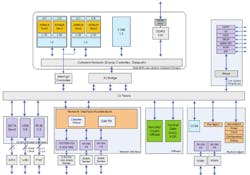This file type includes high resolution graphics and schematics when applicable.
is well known for delivering high-performance, system-on-chip solutions. I recently spoke with Kumar Sankaran, Associate Vice President of Software and Platform Engineering at Applied Micro, about their new HeliX 1 family of embedded processors.
Wong: During ARM TechCon this year, Applied Micro announced its HeliX 1 family of embedded processors. Can you provide more detail?
Sankaran: The HeliX 1 is the world’s first ARMv8 64-bit system-on-chip solution for the embedded market and is based on the same technology as the X-Gene family, the world’s first server-on-a-chip (SOC) solution. While HeliX 1’s and X-Gene’s cores are identical, the input/output (IO) mix of the HeliX 1 is different and suited for the embedded market in terms of lower power, fewer cores (up to four cores), lower clock speed for the cores (from 1.2 to 2 GHz), single-channel DDR memory, six PCIe lanes, one/two SATA ports, and multiple USB 3.0 ports. The HeliX 1 also features the enterprise-class RAS features, and is suitable for the networking market segments (routers and gateways), mid-tier storage like NAS, and multi-function printers.
Wong: In the coming years, what server markets do you see growing in demand?
Sankaran: In the coming years, the demand for cloud and hyperscale, in-memory databases, and data-analytics markets will grow. In addition, storage, which includes warm and cold storage, will continue to grow at a steady rate.
Wong: What do you see as some of the key factors driving ARM in the server space?
Sankaran: ARM-based servers deliver significant cost savings as it relates to total cost of ownership (TCO). TCO is one of the critical factors in data centers today, and decision makers look for TCO savings as the metric to base decisions on. Compared to the competitive landscape, ARM servers provide a significantly reduced TCO in the majority of the workloads used in the cloud hyperscale and high-performance computing markets today.
Additionally, ARM has a long-standing history of providing processors that use very little power. As data centers grow, power consumption, cooling needs, and physical space require greater capital outlays. With ARM servers, users can achieve not only greater density, but dramatically drive down power and cooling requirements. Coupled with the earlier benefits I discussed, customers utilizing ARM technology can deliver a higher performance-per-watt at a reduced cost point.
Wong: As the cloud continues to grow, the demand rises for efficient data-center solutions. How will this shape the competitive landscape and what changes should we expect to see?
Sankaran: As the cloud continues to grow, we will start to see ARM solutions that address all of the market segments mentioned above, including cloud and hyperscale, in-memory databases, data analytics, and warm and cold storage. The embedded community, which has historically used ARM 32-bit cores, will continue to move to ARM 64-bit cores, given the benefits memory bandwidth can deliver and the need for higher performance. Power and performance efficiency will dictate the competitive landscape, and we will see fabrication technology in terms of 28 /16/14-nm-based products come into the market that will offer higher performance and lower power in the same die area for a further reduction in TCO.
Wong: You recently launched an X-Gene-based development kit. Can you talk a little more about that and the impact ARM in servers has on the developer community?
Sankaran: The X-C1 development kit based on the X-Gene 1 device is in production today and being sold by distributors worldwide. The highly integrated, purpose-built X-Gene solution delivers the highest performance and lowest total cost of ownership for private cloud, public cloud and enterprise applications.
The X-Gene development kit includes a hardware reference system and software-development kit featuring production-quality BIOS, compiler, LAMP stack, virtualization and cloud applications (such as open source search), and publishing engines. The bulk of the ARM core infrastructure development is currently being performed using this platform, and we have shipped over 1500 of these platforms to customers and evaluators all over the world.
These include the ARMv8 compiler and tool-chain suite for distributors such as Redhat, Canonical, Debian, OpenSUSE, Montavista/Windriver in the embedded space; debugger vendors in the ARMv8 community; BIOS vendors like AMI; ISVs like Oracle for Java; and open-source organizations like Linaro.
The X-C1 development kit is the first platform in the world to be offered commercially and first to have a real system-on-chip architecture. The platform enables all developers to have access to these key boards, so that every developer can have one on their desk. For instance, the Linaro open-source developer’s community has over 60 boards, and all of its engineers have access to those boards today.
Wong: What’s next for APM?
Sankaran: APM will continue advancing the X-Gene family of products, and we will continue to focus on scale-out applications as well as handle scale-up applications in the next-generation products. Our primary focus will be to provide software-as-a-service and optimize applications and infrastructure deployment on the X-Gene SoC solution. Areas of focus include network function virtualization and Openstack, where the features in X-Gene are ideal.
For our HeliX 1 SoC solution for the embedded market, we will follow the X-Gene train and continue to innovate in specific areas related to the embedded market. Additionally, the HeliX 2 will be announced in the upcoming months.
Wong: Anything else to share on the future of the ARM server market for 2015 and beyond?
Sankaran: The ARM server market segment for this year and beyond looks very promising. This is the first year where we will see data centers actually deploying small clusters of ARM servers. Most of our customers have been in evaluations for the past year or more, and we should see the results of these deployments in 2015. By 2016, we will see an increase in penetration of ARM 64-bit cores into the server market segment.
This file type includes high resolution graphics and schematics when applicable.
References:




